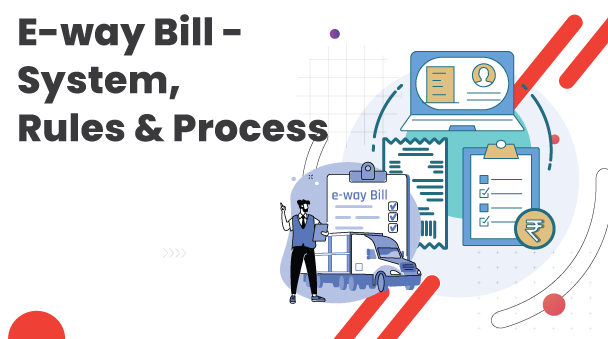Under GST, when goods move from one place to another, the person initiating the goods has to apply for an E-way bill (Electronic waybill) from the E-way bill portal.
From 1st April 2018, any registered person under GST must apply for an E-way bill for the inter-state transportation of goods exceeding the consignment value of INR 50,000 from the E-way bill portal. For the registration of the E-way bill GST, one can apply online through the government portals.
The E-way bill registration can be done by the taxpayers in the e-way bill portal using the GSTIN number generated at GST registration. When products are transported to a port for export, an e-way bill for export is produced. The distance from the warehouse to the port is determined for e-way bill validity purposes.
Certain goods such as petrol, diesel, kerosene, and pearls don’t need an e-way bill while transporting, which is the same for imports and exports. E-way bill Api interface facilitates the taxpayers or transporters to communicate with the E-way bill system to generate, update and pull the data related to their e-way bills.
When Should E-way Bill be Issued?
When there is a transportation of goods valued more than Rs 50,000, an E-way bill is required.
The E-way bill is created in the following situations:-
- When there is a supply of goods.
- When there is a return of goods back to the supplier.
- Due to the inward supply of goods from an unregistered person.
- Here the supply will be either of the following.
- The supply made for the consideration of payment in the course of business.
- The collection made for the review of income which may not be in the course of business.
- In such cases where supply was initiated without payment, supply simply means:
- The sale of goods.
- Transfer of goods, which can be branch transfer, for instance.
- Barter exchange of goods where goods are exchanged.
- Non supply Movement of goods in import/export, recipient not known, exhibition or fairs, and goods used for personal consumption also need an e-way bill.
There are cases where E-way bill registration must be made even if the value of goods is below 50,000.
- When the principal supplies the goods to the job worker, we have to generate an E-way bill.
- The inter-state movement of handicraft goods is exempted from GST registration.
Who Should Generate an E- Way Bill?
The following people need to generate an e-way bill.
- Every registered person must generate an e-way bill if the value of goods is more than INR 50,000, even if the transportation is done through their vehicle or hired means of transport(air, railways, road). The transporter or the registered person chooses to generate an e-way bill even if the consignment value is less than INR 50,000.
- An unregistered person must generate an e-way bill when the goods are transported to the registered person. In such cases, the registered person must follow all the procedures for developing an e-way statement as a supplier since the actual supplier is not a registered person.
- Transporters who carry goods, whether it’s through the air, road, or railways, must generate an e-way bill in such cases where the consignor and consignee fail to generate.
To determine the validity period of the E-way bill distance traveled is calculated. The validity period of the e-way bill date can be extended 8 hours before the expiry or within 8 hours after the expiry.
Rules to Generating an E-Way Bill
The CGST rules 138 of 2017 say that every person transporting goods, irrespective of the value being more than Rs 50,000, is subjected to be registered under the E-way bill GST.
The details regarding goods should be added in part A of the E-way bill, and adding the vehicle details in part B will generate an e-way bill for the taxpayer.
How to Generate an E-Way Bill
Before registering for the e-way bill, ensure that the taxpayer has registered in the E-way bill portal. The steps to generate an E-way bill from the E-way bill portal are given below.
Step 1: Using your credentials, log in to the E-way bill portal.
Source:ewaybillgst.gov.in
Step 2: Select the ‘Generate new’ option under the E-way bill appearing on the left-hand side of the dashboard.
Step 3: In the E-way bill entry form, give the following details as transaction details, subtype, document type, document number, and document date. In ‘Transaction details,’ the transaction type must be outward if the taxpayer is the supplier and inward if the taxpayer is the recipient.
Step 4: Depending upon the supplier or recipient, submit all the information under the ‘From and To section.’
Step 5: Fill in all the details regarding the items to be transported under the section ‘Item details’
Step 6: Fill the section ‘Transporter Details’ depending upon the mode of transportation
Step 7: Post filling the details, you can click on the submit button.. Here is an E-way bill demo
Source: ewaybillgst.gov.in
An E-way bill by sms can be generated for the application or cancellation of the e-way bill. After logging in to EWB Portal, by clicking on the registration, select the SMS option.
Conclusion
An E-way bill is a system used to ensure that the goods transported comply with GST Law. When it comes to tracking and checking tax evasion, e-way bills are an excellent and efficient tool to consider. Learn more about the e-way bill to ensure that every consignment transaction is registered under the E-way bill portal to avoid a penalty of 10,000 for non-compliance.
Want to get a free E Way Bill Demo?Click Here for more details.

